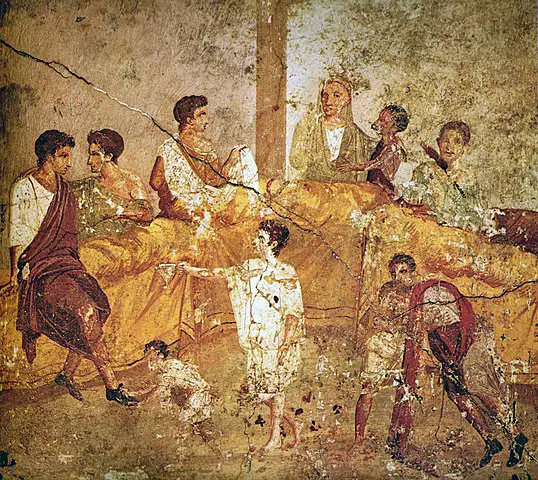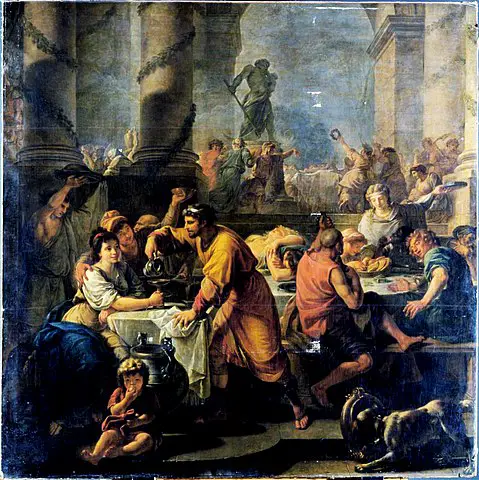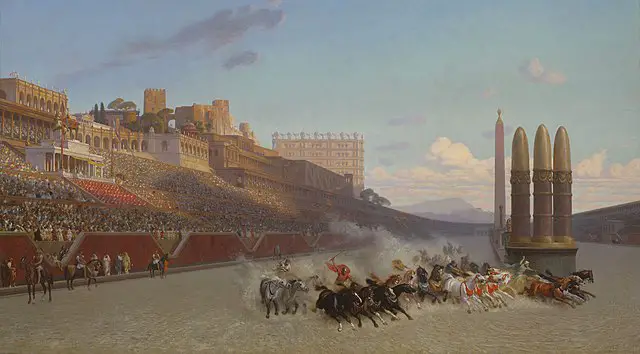
| Further Reading | 5 Facts About Roman Chariot Racing |
If you lived in ancient Rome you would have been surrounded by people from all walks of life. Rome attracted everybody and with them came different cultures, customs, and forms of entertainment. In spite of the vast amount of entertainment that the Roman people had at their disposal the Roman people loved above all else chariot racing!
The populus Romanus or Roman people loved chariot racing for 3 reasons. First, chariot racing allowed the Roman people to gamble large sums in real-time at a large track. Second, the Roman people were extremely religious and chariot racing often gave praise to the Roman gods through iconography. Third, the Roman people loved chariot racing because it was a brutal sport.
Here at The History Ace, I strive to publish the best history articles on the internet. If at the end of this article, you enjoyed it then consider subscribing to the free newsletter and sharing it around the web.
Without further ado, here is an entire article explaining why the Roman people loved chariot racing.
The Roman People Loved Chariot Racing Because It Allowed Them to Gamble in a Large Sporting Venue

The Roman people loved to gamble almost as much as they loved chariot races. Gambling was so widespread across Rome that even the Roman Emperors took part in it.
The Romans would gamble on anything. Most people were poor and this gave them the opportunity to get a little bet extra money or goods to live off. Since food and water was provided by the Roman government the extra money a Roman would make through either gambling or working would allow them to buy extra goods.
Further, the Romans believed that the reason that a gambler won was because of fate. Religion and ritual dictated a large portion of Roman life. Because of this if a gambler lost they often thought that they had done something wrong to deserve such a fate. On the other hand, if a gambler won it was a sign that their fate was better than those around them.
While the most common method of gambling for Romans was dice the favorite was sport betting. Out of all sports, the Romans played none drawing a larger crowd than chariot racing. The Circus Maximus in Rome could hold an astounding 150,000 Roman spectators. Further, the winning racer in these circuses could win a huge pile of money (60,000 sesterces in some cases!).
As such, Roman chariot racing allowed the Roman people to bet money on the race. They would all file into the stadium and take their seats. Watching the chariots swinging around the track the Roman people would all start taking wagers on which horse would win or which rider would fall.
If you attended one of these ancient races not only would you see horses swinging around the track at high speeds but you would also hear the shouts of Romans placing wagers. Simply put, the Roman people loved gambling and they loved chariot racing. The combination of these two things is a major reason why chariot racing was the most loved sport in ancient Rome.
The Roman People Were Extremely Religious and Loved Chariot Racing Because It Allowed Them to Demonstrate Their Piety

Most Romans were illiterate; they communicated through speech and more importantly iconography. This speech and iconography ‘dialect’ is important because it is also how Romans would partake in Roman religious rituals. The Roman chariot race was not just a race, it was a religious ritual and the Romans loved it.
Historians have theorized that the race tracks around Rome were designed to not only be practical for racing but also allow mass culture to be transmitted to the crowds. This mass culture came in the form of iconography and orations given before and after a race.
The Roman racetrack itself was designed from the ground up to be viewed by massive amounts of people. The anatomy of the track consisted of two major parts. First was the large oval track which was built to house upwards of 25 horses. Second, was the central divider that was in the center of the track and built to enforce the oval confines of the track.
This central divider of a Roman chariot race track is called the Spina or spine. It runs down the central part of the track and was visible to all Roman spectators. This Spina of the Roman chariot race track was a sacred part of the track. Images and statues of Rome gods would be placed here in the dead center of the track.
Roman chariot racers would risk their lives to win the attention of these Roman gods. With each turn of the track they would see the religious iconography placed to their left and the Roman people cheering them on to the right.
The view of the Roman people was just as amazing. Looking downwards from their elevated position ( either on a hill or bleachers depending on the track) the Roman people would see an oval. In the center of this oval would be the Spina. On top of this Spina, in the dead center of the entire Roman complex, would sit images of Roman gods. Outside of this Spina the Roman people would see upwards of 25 chariot racers flying around the track. They would be kicking up dirt and attempting to safely navigate around other riders.
The Roman chariot race was not just a race for entertainment. The race from the ground up was designed to be a religious event that would transmit Roman culture to the spectators. The Roman people loved this and as such they loved Roman chariot races.
The Roman People Loved Chariot Racing Because It Was Dangerous

Roman society loved physically intensive exercise. Further, they loved seeing people engaging in extreme physical exercise that was dangerous. While many people would instantly think of gladiatorial combat in the Colosseum as the most dangerous this paled in comparison to the violence of chariot racing.
Roman chariot racing was not just horses and people flying around a track as fast as they could. The Roman chariot racer was also competing to get the most attention from the Roman people and gods. Flashy colors, dangerous stunts, deadly crashes, and rider-on-rider combat mid-race were common.
For example, a Roman chariot racer would often have 3 or 4 horses tied to their chariot. This was because more horses would demonstrate the more advanced skill of the chariot racer. However, the average human body can’t easily steer 4 large horses with handheld reigns. To solve this the Roman chariot racer would tie extra harnesses around their torso and ‘lean’ along with steering the horses.
Imagine you have the reigns of 4 horses tied around your body. Now imagine your chariot breaking or you falling and what would happen as the horses scatter. This was common on the larger race tracks around the Roman Republic and Empire. The Roman People loved violent, fast, and extreme sports. There was none more violent, extreme, and fast as Roman chariot racing.
Further, the chariot racers of Rome carried a small sword on their hip. This sword served two purposes; first to cut the ropes in case the chariot broke and second to ‘dissuade’ other chariot racers from getting close. If you attended a Roman chariot race it would be uncommon to see sword fights break out between riders as they attempt to steer around the track.
On top of all of this most chariot tracks in the Roman Empire were built to house upwards of 25 chariots. With 25 chariots you would have chaos on the track and the Roman people loved it. Riders would fight each other, fly into the walls of the track, or be dragged behind their horses as there chariot fell apart from under them.
Also, the chariots themselves were designed to be as light and fast as possible. This means very little protection for the rider. In fact, the priority list of the design of a Roman chariot was as follows; first was speed, second was religious iconography and design, and finally maybe some protection for the rider.
As such, one of the major reasons why the people of Rome loved chariot racing was because of just how brutal of a sport it was. Roman chariot racing was so dangerous that if you were a rider it was expected that you would eventually pass away in the sport. Unlike gladiators who were trained and given armor a chariot rider was given virtually no protection.
Conclusion
There you have it; an entire article dedicated to why the Roman people loved chariot racing so much.
Chariot racing is often eclipsed by gladiatorial combat sports because of movies and books. However, if you lived in ancient Rome and had the option to attend a chariot race or gladiatorial show you would often pick a chariot race.
I hope you enjoyed the article. Here at The History Ace I strive to publish the best history articles on the internet. Feel free to sign up for the free newsletter and share around the internet, every share helps me help others discover their love for history.
Further, you can check out some of the other articles below.
-
Why The Roman People Loved Chariot Racing

Why did the Roman people love chariot racing? Well it all comes down to these 3 reasons.

